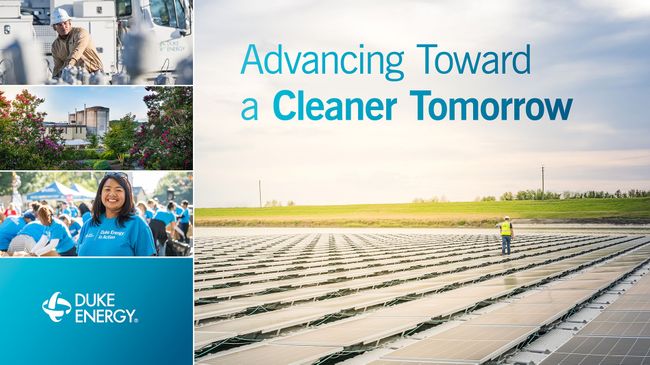Duke Energy’s Annual Impact Report Shares Progress Toward a Cleaner Tomorrow That Includes Affordability and Reliability
- Carbon emissions from electric generation down by 48% since 2005
- Assisted customers in accessing nearly $377 million in financial support since 2022
- Investments in grid technology resulted in improved service and avoided 1.5 million power outages in 2023
- Focused on clean energy transition strategy for a more diverse energy mix and reduced carbon emissions
- Commitment to sustainability and community support
- None.
- Carbon emissions from electric generation are down
48% from 2005 levels - Since 2022, helped customers access nearly
$377 million in financial support
CHARLOTTE, NC / ACCESSWIRE / April 25, 2024 / Duke Energy (NYSE:DUK) released its 2023 Impact Report, its 18th annual accounting of its progress toward its sustainable business goals. This year's report includes highlights from its 2050 clean energy transition strategy, which strives to deliver industry-leading reliability, competitive rates for customers, and accelerated infrastructure and economic development to meet the growing needs of its more than 8 million customers.
Examples highlighted include the many ways in which Duke Energy offers customers options for controlling their energy use, as well as the assistance it provides to its customers in need. Over the past two years, the company has helped customers access nearly
In pursuing its clean energy transition strategy, Duke Energy works alongside its stakeholders as it drives toward delivering a cleaner, more diverse mix of energy sources while accounting for the significant engineering, environmental and social considerations embedded in such a transformation, one of the country's largest in the utility sector.
"As the company executes its clean energy transition, it is assembling a sophisticated puzzle," said Katherine Neebe, Duke Energy's chief sustainability officer. "Each piece - energy generation and storage, grid modernization, supporting communities and working with various stakeholders, multiskilling employees and reducing carbon emissions - is essential. It's about finding the perfect fit for each piece to create a final picture that reveals a landscape of sustainable and interconnected solutions."
Other report highlights and insights include:
- Duke Energy continues to decarbonize to meet its climate goals. The company's carbon emissions from electric generation are down
48% since 2005 and it is on track to meet its interim50% carbon emission reduction target by 2030. The path to net-zero is not linear. Duke Energy anticipates some fluctuations in its carbon emissions in the short term as coal is retired and other forms of generation are brought online. - The company is leading the industry with net-zero goals that address
95% of the company's Scope 1, 2 and certain Scope 3 calculated greenhouse gas footprint. - The company continues to decarbonize its natural gas business unit with a focus on methane detection and reduction of emissions related to the gas it purchases as well as the downstream carbon emissions related to its customers' consumption of the gas it sells. Duke Energy is also investing in renewable natural gas as an important tool to tackle greenhouse gas emissions.
- Duke Energy advocates for policies that reduce the customer rate impacts of investments in clean energy infrastructure as well as support the energy transition, such as the Infrastructure Investment and Jobs Act (IIJA) and federal energy tax credits like those included in the Inflation Reduction Act.
- Duke Energy submitted 15 IIJA-funded applications to reduce the cost of developing and deploying clean energy technologies and grid improvements in an effort to maintain customer affordability.
- The company's economic development team, working with state and local authorities, helped attract 15,000 new jobs and
$22 billion in capital investment. - Environmental justice is critical to engaging communities in the clean energy transition and the company is evolving this work by putting its principles in action. In addition, the team completed over 100 initial environmental justice assessments as part of a holistic approach to project development and execution as well as the development of statewide and regional environmental justice advisory councils across North Carolina.
- As the energy sector transitions, the company is working to ensure its workforce and others in the industry are set up for long-term success. As part of this commitment, a team worked collaboratively with various groups to develop a first-of-its-kind just transition approach resource as a guide for successful engagement. Transparency and communication will help the company achieve the most equitable solutions. In 2023, the company and its Foundation provided
$120,000 in employee-led giving to benefit coal plant communities. - Inclusive actions drive business outcomes to create a workplace where everyone thrives. To deliver reliable products and services that meet community needs, the company depends on a skilled and diverse workforce and continually evolves its hiring practices to attract qualified professionals.
How the company mitigates the risks associated with its business, while at the same time creating value for its employees, customers and communities, is foundational to creating lasting impact. It takes time to work through all of the complexities of the clean energy transition, and the company is focused on these opportunities every day.
Duke Energy
Duke Energy (NYSE: DUK), a Fortune 150 company headquartered in Charlotte, N.C., is one of America's largest energy holding companies.
The company's electric utilities serve 8.4 million customers in North Carolina, South Carolina, Florida, Indiana, Ohio and Kentucky, and collectively own approximately 54,800 megawatts of energy capacity. Its natural gas utilities serve 1.7 million customers in North Carolina, South Carolina, Tennessee, Ohio and Kentucky.
Duke Energy is executing an ambitious clean energy transition, keeping reliability, affordability and accessibility at the forefront as the company works toward net-zero methane emissions from its natural gas business by 2030 and net-zero carbon emissions from electricity generation by 2050. The company is investing in major electric grid upgrades and cleaner generation, including expanded energy storage, renewables, natural gas and nuclear.
More information is available at duke-energy.com and the Duke Energy News Center. Follow Duke Energy on Twitter, LinkedIn, Instagram and Facebook, and visit illumination for stories about the people and innovations powering our energy transition.
Contact: Shawna Berger
24-Hour: 800.559.3853
Twitter: @DE_ShawnaB
View original content here.

View additional multimedia and more ESG storytelling from Duke Energy on 3blmedia.com.
Contact Info:
Spokesperson: Duke Energy
Website: https://www.3blmedia.com/profiles/duke-energy
Email: info@3blmedia.com
SOURCE: Duke Energy
View the original press release on accesswire.com
FAQ
How much have carbon emissions from electric generation decreased since 2005?
How much financial support has Duke Energy helped customers access since 2022?
How many power outages were avoided by Duke Energy's smart grid technologies in 2023?
What is Duke Energy's clean energy transition strategy focused on?







